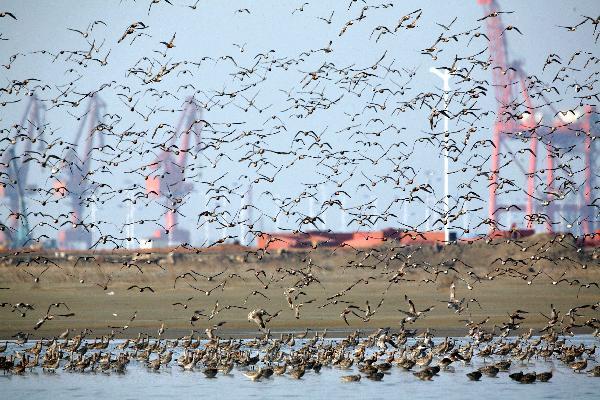
A large flock of birds hover over the birds-viewing garden on the wetland at the estuary of the Yalu River, bordering on China and the Democratic People's Republic
UNESCO recently added two migratory bird sanctuaries in Northeast China's Liaoning province to the World Heritage List during the 46th session of the UNESCO World Heritage Committee in New Delhi, India. Snake Island in the Laotieshan National Nature Reserve and the Dandong Yalu River Estuary secured the spot thanks to their cultural, historical and scientific significance.
Snake Island is part of the Snake Island-Laotieshan National Nature Reserve in Dalian's Lyushunkou district. It is an ideal stopover spot for migratory birds as they fly south across the Bohai Strait.
One animal that benefits from the migration is the unique Shedao island pitviper (Gloidyus shedaoensis), which preys on small birds as they make their biannual journey. Snake Island is home to nearly 20,000 of these venomous snakes, which are endemic to the area.
The island is also a breeding ground for waterbirds, including the yellow-billed egret, which the International Union for Conservation of Nature lists as vulnerable.
The Yalu River Estuary migratory bird sanctuary lies at the northernmost tip of the Yellow Sea-Bohai Gulf ecological region. It includes an intertidal zone system, meaning it is characterized by the constant ebb and flow of the tides, which dramatic changes in water levels and environmental conditions throughout the day.
Each year, from March to May, the sanctuary welcomes hundreds of thousands of shorebirds on their migratory journey from Australia, New Zealand, Southeast Asia and beyond, offering a rest and refueling stop before their final destinations in the Russian Far East and Alaska.
With 324 bird species documented in the region, including four critically threatened species, six endangered species, and 13 vulnerable species on the IUCN Red List of Threatened Species, the sanctuaries are pivotal for preserving avian biodiversity.
The two Liaoning bird sanctuaries are part of a group of five sites that count as extensions of previous entries to the World Heritage List in 2019.




